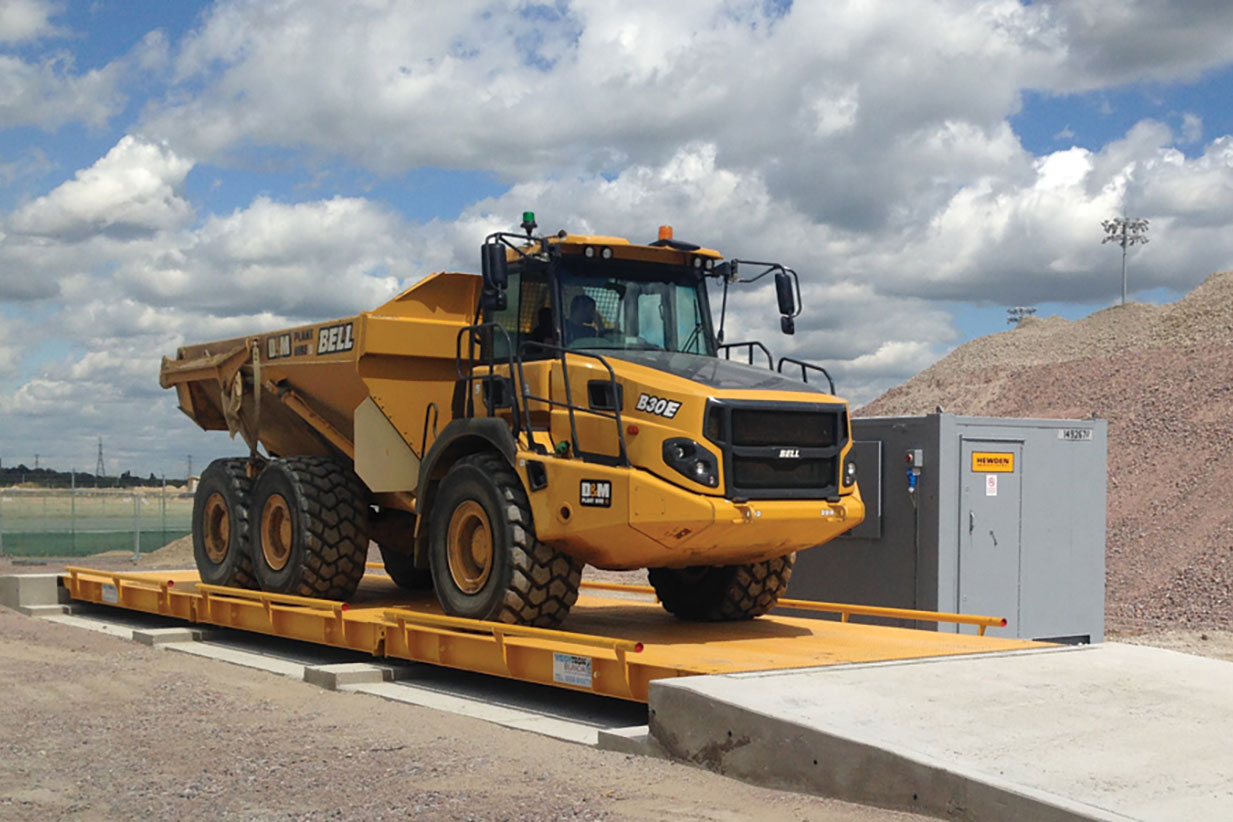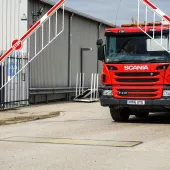The Changing Role of Weighbridges in Quarries

First published in the March 2018 issue of Quarry Management as Weighing up the Options
Weighing specialists Weightron provide a detailed overview of the changing role of weighbridges in quarries
Accurate weight data collection is a vital function within the quarrying industry with weighbridge management systems playing a pivotal role in providing this essential information.
However, the concept of a stand-alone weighbridge and adjacent weighbridge office, housing a straightforward weight indicator and ticket printer, is becoming a thing of the past in more and more applications. Weighbridge systems are now powerful and versatile management tools, playing a much wider role by acting as critical control points for managing the movement of vehicles and materials arriving at and departing from quarry sites, whilst collecting and processing vital weight data.
This is changing the way weighbridge systems are required to operate and how they integrate with peripheral vehicle control equipment, safety equipment and established management software systems. Driver-operated weighbridges are becoming more widespread, providing optimum flexibility and extending operational hours.
However, as Weightron’s sales manager, Nick Burley, points out, quarries present one of the toughest environments for weighbridges and, therefore, the correct choice of weighbridge is at the heart of performance and long-term reliability, with engineering design and build quality playing a vital role.
Choosing the right weighbridge system
There are a number of critical design and operational issues that potential purchasers of weighbridge systems should consider from the outset. Five distinct areas need to be considered:
- The number of weighbridges and their location
- The design and build of the weighbridge for optimum reliability
- The pedigree of key measurement-chain components (load-cells and instrumentation)
- Integration of required peripheral control equipment, such as automatic number plate recognition (ANPR) cameras, traffic lights and barriers
- Software functionality and software integration.
The number of weighbridges required at a site should take into account anticipated maximum traffic throughput densities and overall site efficiency requirements. Dedicated ‘In’ and ‘Out’ weighbridges are essential for busy sites and it can be prudent to have two incoming bridges and one outgoing bridge to avoid bottlenecks. Although the cost implications may seem higher initially, having to install an additional weighbridge at a later stage will cause major site disruption and incur significant civil engineering costs.
Installing bidirectional weighbridges where key instrumentation and control features are mirrored at each end has a number of advantages. This gives flexibility for busy periods and allows weighbridge(s) to be taken out of service for maintenance with minimum impact on site efficiency.
Weighbridge design
There are essentially two main design concepts – pit mounted and surface mounted. The choice for any particular application will depend on a range of factors including: the required site layout, site permanency, vehicle access and cost restraints. Civil engineering costs for surface weighbridges tend to be lower, but the access ramps can slow down vehicle throughput. Surface weighbridges are easier to relocate making them ideal for temporary sites. By comparison, pit weighbridges provide a level approach and exit surface. An alternative combines both design concepts, whereby the bridge structure is essentially installed without pit sides (allowing more open drainage and easy visual inspection), but the approach and exit roads are designed to present level surfaces.
Weighbridges may appear to be merely pieces of metal or concrete, but sound mechanical design and build procedures are essential both for performance and longevity. In parallel, well-designed foundations and vehicle approach areas also play a vital role. Cutting corners with factors such as steel quality, support beam density, weld integrity or surface finish may reduce prices, but this will almost certainly have a detrimental effect on overall long-term reliability.
EN1090
Since 1 July 2014 it has been a legal requirement within the UK that all structural steelwork for use within civil engineering works must be CE marked in accordance with EN1090. This CE requirement, regulated by Trading Standards, is based on the European Construction Product Regulation (CPR). Steel weighbridges and associated structures fall within this regulation and manufacturers must be assessed and certified by a notified body. Engineering contractors and insurance companies underwriting works will expect structural steel arriving at site to be CE marked with the supporting declarations of performance certificate. Meeting this legislation requires strict in-house controls relating to the design, material selection and manufacture of weighbridges.
Weighbridge measuring chain
A typical weighbridge measuring chain includes the load-cells, junction boxes, driver terminals, weight indicators, large remote displays, and software. To ensure optimum system compatibility, there are distinct advantages for the customer if the weighbridge supplier is responsible for the design and manufacture of all these critical components. This provides practical and efficient single-source system responsibility. In addition, purchasers should look at the level of after-sales support a supplier can offer, together with their quality system accreditation and relevant trade association membership.
Load-cells
The load-cells and their associated mounting hardware are considered to be the most crucial part of the weighbridge and are required to work under a range of harsh and challenging environments. Therefore, design and application optimization for these essential components is crucial, not only for performance, but also for long-term reliability.
Of all the designs, clear evidence from the field shows that compact stainless steel canister load-cells, together with well-designed rocker mounting assemblies, provide the optimum solution for weighbridges. More cumbersome single-ended bending-beam load-cells or vulnerable double-ended shear beams with ball bearing mountings are more likely to fail and generally require more ongoing maintenance. It should be remembered that weighbridge decks can be subject to relatively large temperature-related expansions and contractions, which affect the load introduction angles, and this places further importance on the requirement for well-designed load-cells and mounting assemblies.
The latest digital load-cell designs offer a range of benefits including more efficient commissioning, remote diagnostics, easier calibration and quicker replacement if the load-cells are damaged.
Environmental sealing is a vital factor for load-cells, especially in pit-mounted designs where flooding can occur. The latest design of fully weld-sealed load-cells meets the onerous IP69K classification, initially introduced for the hot wash-down testing of off-road vehicles. This demonstrates that the load-cells can withstand high-pressure steam cleaning in line with the stringent test specification outlined in the German DIN 40 050-9 standard.
Instrumentation
Traditional weighbridge instrumentation has developed significantly over the past decade. Intuitive driver-operated touch-screen terminals adjacent to the weighbridges have replaced standard weight indicators housed in the weighbridge office. These robust terminals provide a wealth of operational and management features. For optimum site efficiency dual-height terminals allow easy access for drivers in a range of different vehicles, including lorries and vans. Even if the vehicle in question does not need to be weighed, the terminals can act as a vehicle control point. Additional bypass lanes with single- or multi-use card readers can also be linked to the weighbridge system to control non-weighed vehicle access to different parts of a site.
Software
Today’s weighbridge systems are expected to integrate seamlessly with an array of management software systems including SAP, Sage, Microsoft Navision and J D Edwards. However, although system functionality for a specific project may appear to be well defined at the outset, functional design specifications invariably change throughout a project. As a result, it is beneficial for the weighbridge supplier to take responsibility not just for the weighbridge software, but also for the all-important interface between the weighbridge system and the overall plant management system.
The use of third party software suppliers, who have little or no knowledge of weighing, can turn out to be more complicated and expensive in the long run. In parallel, the weighbridge software must be fully compatible with the growing range of peripheral equipment, including ANPR cameras, overhead cameras, control barriers, traffic lights, card readers and radiation-detection systems.
Storage software
Versatile storage software, linked in with the weighbridge system, provides invaluable inventory control where different materials are delivered to and collected from sites by a wide range of contractors. In such applications, these products may be processed straight away or stored on site. Such software also manages processed materials being collected from site. A range of data analysis reports effectively controls stock movement in and out of the site, providing information for invoicing, reprocessing and recycling efficiencies together with other important site parameters. The weighbridge(s) act as critical control points in such applications.
Caveat – End-users should explore the future-proof capabilities of software and instrumentation. It is important to check how easy it is to set up or reconfigure fundamental features such as databases and libraries. Driver terminals must be capable of operating with the wide array of recognition technologies, such as RFID, magnetic and voice activation.
Peripheral control equipment
Control barriers and traffic lights
Barriers and lights at each end of a weighbridge are effective at controlling the vehicle access to and from the weighbridge. The system is designed so that the weighing process can only take place when the correct sequence of these control features is in place.
Vehicle recognition systems
A range of options is available to identify vehicles entering and leaving the weighbridges. Automatic number plate recognition (ANPR) cameras are very effective at identifying vehicles whose data are entered into the system database. Details relating to vehicle, contractor, product and even vehicle tare weight can be stored. The vehicle is identified as it approaches the bridge and is only allowed access if the stored information is correct.
Preventative maintenance
A well-organized preventative maintenance regime is essential for quarry-based weighbridge systems. This operating environment is particularly harsh, but simple steps carried out routinely can maximize operational effectiveness and minimize breakdowns. A preventative maintenance programme should include regular visual inspections and simple cleaning routines. The inspections should be carried out on the weighbridge itself, as well as the approach roads and peripheral equipment. Pit weighbridges should be fitted with ‘T’ rubber around the edges of the pit–deck interface to prevent debris entering the pit. This rubber can become damaged over time or may be inadvertently removed. Drainage for the weighbridge and the surrounding areas must be kept in good condition. Extra checks should be made during periods of heavy rain and snow. Winter deck cleaning should avoid the use of salt, while regular hosing down will remove any salt deposited from vehicles. The use of dedicated wheel-washing equipment adjacent to the weighbridge can minimize problems of dirt build-up.
It is worth noting that a quick way to check whether the weighbridge is working is to stand on it at various places. Most weighbridges weigh in 20kg increments and the system should certainly register a person weighing 60kg or more.
Service and support
Although an effective preventative maintenance regime is important, this should always be backed up by a structured service plan. Weighbridges are expected to work reliably and accurately day after day in all types of environments. It is easy to forget that underneath the deck structure are precision measuring sensors that can provide weight data to one part in 3,000. Effective rapid-response support is essential for weighbridges to minimize quarry downtime. This is far easier if the original supplier has supplied and installed the complete system and also has readily available trained engineers.
It is prudent, therefore, for operators to invest in a comprehensive service and support agreement. This will ensure that ongoing maintenance and calibration is carried out within the manufacturer’s specifications and the weighbridge continues to meet legal-for-trade legislation.
Conclusion
Weighbridges are at the heart of quarry operations and reliability is extremely important. Therefore, making an informed choice from the outset is essential. Choosing a weighing company that can supply the complete weighbridge system, including key peripheral equipment and software, offers distinct advantages. As weighbridge systems become more demanding and operationally complex, the pitfalls of buying on price increase. It is recognized that cost is an important factor, but the apparent advantages of initial low prices can soon be lost through operational limitations and unreliability, and altering designs once systems have been installed can be very expensive in terms of additional civil work, cabling and software changes.
For more information visit: www.weightron.com
- Subscribe to Quarry Management, the monthly journal for the mineral products industry, to read articles before they appear on Agg-Net.com




